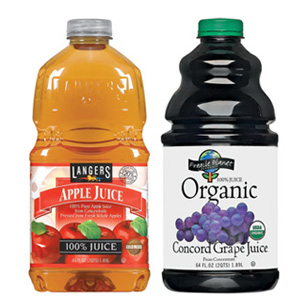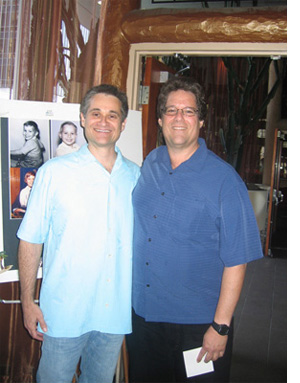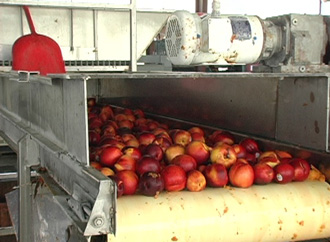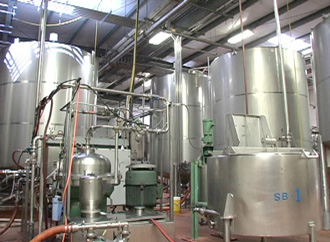
Lessons in Langer Management
 Say it's a Friday in October. You're shopping in a Sprouts Farmers Market store, and a ray of sunshine slants down from the skylight, illuminating the brilliant garnet color in a bottle of Langers Pomegranate Juice. You pick up the bottle, put it in your cart... with not a thought given to how it came to be there, or how the bottle was made, or how the juice was squeezed, or when the pomegranates were picked.
Say it's a Friday in October. You're shopping in a Sprouts Farmers Market store, and a ray of sunshine slants down from the skylight, illuminating the brilliant garnet color in a bottle of Langers Pomegranate Juice. You pick up the bottle, put it in your cart... with not a thought given to how it came to be there, or how the bottle was made, or how the juice was squeezed, or when the pomegranates were picked.
But if you could somehow sequence the DNA of that juice, and trace it all back to its source, what you'd find is a series of activities — from picking to pressing to pasteurizing to palletizing, with dozens of other steps in between — that makes each and every bottle of Langers Juice a superb study in syncopation. And it all starts with the Langer family.
*****
 |
| Bruce and David Langer |
To understand how Bruce and David Langer got to this point — two smart, quiet Southern California boys overseeing a booming $180 million juice company (is there any such thing as a juice empire?) — you need to go back a ways. Back to the Old Country, to Poland, where their grandfather grew grapes and produced wine, or to San Diego, circa 1960, when their father, Nathan, bought a business called "VegeJuice" and sold celery juice to stores and through a home delivery van. Juice, it would seem, runs through their veins.
David, four years the elder, worked in the family business throughout high school, learning the ins and outs. Bruce, on the other hand, after growing up around the business, was thinking about a "juicier" income, and eventually went off to law school. But while he was interviewing with law firms, Nathan and David made him a very good offer, and he decided to join them.
"In hindsight," laughs the counselor-at-juice Bruce, "I don't think it was a very good negotiation for them. But it was for me."
The verdict is in. Today, a quarter of a century later, Langers Juice Company ranks as one of the most highly respected juice producers in the country, and one of the ten largest. They have built a super-efficient, vertically integrated business that enables them to go from farm to shelf in a very short period of time. Langers operates four plants in California, where they press and bottle juice and carbonated juice, and even "blow" some of their own bottles. They employ 300 people and work with contract facilities elsewhere in the country, producing more than 200 beverages that are distributed coast to coast and around the world.
*****
The juice-making process is not that complex, not really. Anyone who has ever thrown a few Valencia oranges into the juicer knows that. You get some fruit. You remove the parts you don't want. You squeeze it. Maybe you strain it or filter it. You pour it into a glass.
 |
| The Bakersfield grading process is peachy-keen. |
That is exactly what they do at the Langers Juice Company. Only, they do it on a scale most of us cannot even comprehend. Think, truckload after truckload of fresh fruit. An enormous hydraulic press that crushes 24 tons of fruit at once. 13,000-gallon holding tanks. A computerized high-speed bottling operation, with conveyor belts moving every which way, that can fill 450 64 oz. bottles per minute. That sort of thing.
It all starts at Langer Farms, a rather nondescript 17-acre facility near Bakersfield, CA, in the dusty southern end of the San Joaquin Valley.
Wave after wave of flatbed trucks roll in, each carrying wooden crates filled with fruit. Pomegranates, apples, maybe oranges. Today it is peaches. Lots of ripe, fragrant peaches. Despite the dust and the diesel exhaust and all the industrial machinery around, this place smells like an orchard.

The peaches are off-loaded and stored temporarily, before being lifted into the "dump bin" at the grading machine. There, everything gets washed and inspected, with a worker hovering over the belt to remove any twigs or bad fruit, or the occasional plum that sneaks its way into the load. The conveyor then takes the surviving peaches up at about a 30-degree angle into the adjacent building, where they begin the sinuous journey that will end up in a bottle on your shelf in an amazingly short time.
 |
| Meet the press: 24-tons of hydraulic juice-goosing power. |
First, however, there is the little matter of that pit. A loud machine reaches into the core of each fruit, extracts the peach pit, and grinds it up into little pieces, which are then used as biofuel in
wood-burning power generation. Meanwhile, the flesh of the peaches gets sent over to the presses. Langers has three presses in Bakersfield, the largest of which is an augur-driven hydraulic monster capable of flattening 24 tons of fruit at once; the other two smaller ones are "pressed" into service when needed. Picture a tunnel, about 8 feet in diameter, with an interior wall that slowly moves from one end to the other — kind of like the ones the arch-villains use when they are trying to do away with the superhero. Only, these peaches don't escape. The juice gets pumped over into giant stainless steel silos, while the remaining solids are removed, loaded into waiting trucks, and shipped out as cattle feed. On a typical day of peach pressing in Bakersfield, Langers generates about 20 to 40 tons of peach waste. Meaning, there are a lot of fat and happy cattle nearby.
 |
| Behind a steely façade, sweet things happen in the processing room. |
The peach juice eventually gets sent over to the "process room," where it goes through a phalanx of other machines. There is a centrifuge that spins at thousands of revolutions per minute, accompanied by an intermittent ear-splitting noise. There is a gadget that removes some of the color — which might seem odd, but think about how picky you are about the color of the apple juice you buy. There is a machine that strips out the volatile alcohols that make a peach smell like a peach (elsewhere in the plant, there are buckets labeled "yellow peach essence," which may be added back to the juice based on what the final product is). There is a vacuum boiler that can be employed to make the juice into concentrate, which is sold to some other companies and is sometimes used to make juice blends — one ton of juice yields 20 gallons of concentrate. And there is something called an ultrafiltration unit that looks kind of like an industrial large intestine, with long tubes doubling back on themselves repeatedly. The juice works its ways through these tubes for further purification, and is ultimately loaded into 55-gallon drums for shipment to the bottling plant. The whole crazy, convoluted process has taken only a few hours.
But the fun has only just begun.
*****
 |
| The Grape Escape: Cases of Langers, ready to be shipped off to a Sprouts near you. |
At the sprawling 140,000-square-foot Langers bottling plant in the aptly named City of Industry, about 30 miles east of Los Angeles, the juice (or, "the fruit," as David Langer still refers to it at this stage) arrives — either in drums, or in the case of white grape juice, in tanker trucks. All of it is initially stored in "the refrigerator" — a dimly lit 10,000-square-foot room that will make you forget what the temperature is outside. Walking up and down the aisles is like moving through a virtual chilled fruit salad: Pink Guava, Alphonso Mango, Granny Smith Apple, Cranberry, and so on. Langers makes a number of different juice blends, and also likes to mix different varietals of apples to achieve just the right flavor profile, so it's important to maintain a broad inventory.
The juice gets mixed together in huge steel vats that are sunken down below floor level in an adjoining room, with a vast network of steel pipes flying overhead, and is then pumped into the pasteurizing machine. Here it gets heated to remove any microbes. This is a carefully controlled process, because if you heat it too high or too long, the juice cooks and loses its flavor. This is just one of many precautions that Langers takes to ensure that its products are 100% safe. A few steps away there is a laboratory, where samples are taken from every single batch of juice and are run through an assembly line of impressive-sounding machines: a spectrophotometer (to check the color), a turbidimeter (to test the clarity), an acidity titration unit (to measure pH), and others. Technicians watch the juice samples swirl around beakers, and monitor the digital readouts to ensure that Langers is fully compliant with all government standards.
 |
| Bottle bottleneck? |
Inside the bottling room, empty plastic bottles are taken off pallets, turned upside-down, and cleaned with either de-ionized air or de-ionized water. Then they are set down in a machine that queues them up, first 20 or so across, then 10-wide, eventually single-file. It looks like a crowd of concert-goers just as the gates open. The bottles whiz down a conveyor toward a huge German-built filling machine, where a computerized valve-and-probe system controls the juice levels with precision, not a fraction of an ounce over or under. There is also a Wonka-like machine that sucks bottle caps up into a pneumatic tube and affixes them to the bottles. Every single one gets photographed by a computer, and if any caps are found to be askew, the machine pulls those bottles off the line. Once filled and capped, the juices go through cooling tunnels for about 45 minutes, get labeled, packed into specially made 8-sided boxes, placed on pallets, wrapped in plastic by a robot, and then put onto waiting trucks for shipment to distributors and stores.
This whole setup, all these belts and machines and computers, this giant juicy gee-whiz-gizmo, is run by a group of about 12 Langers employees on any given shift. It's truly marvelous to behold — whether you are a visitor to the plant, or Nathan Langer, now in his 80s, who still comes into work every day, and looks on with pride and astonishment.
******
Bruce and David sit in a conference room in the office portion of their plant in City of Industry, discussing their state-of-the-art machinery and reflecting on how far the company has come.
"Innovation really drove the growth of our business," says Bruce, who heads up sales and marketing. "I think quality drives the sustainability of it, but innovation drove the growth."
In the late 1980s, they were still just a local Los Angeles company (and Henry Boney, the late patriarch of the family that would later found Sprouts, was one of their largest customers). But then they became the first major juice company in Southern California to use light plastic "PET" bottles, and, because that enabled them to start shipping the product nationally, they became a major player almost overnight. "The world changed," says Bruce, "and it wasn't possible to stay a little Southern California company anymore."
Today, of course, between their juices, juice blends, no-sugar-added juices and Fragile Planet organic line, Langers is the anchor of the juice aisle in Sprouts stores.
David adds that eco-consciousness has also been a major initative catapulting Langer to its current success. Take the 8-sided boxes. "Unlike traditional square cases," he notes, "these have extra stacking strength while using 10% less corrugated cardboard. Additionally, all of our corrugated suppliers are part of SFI, the Sustainable Forestry Initiative, which means that for every tree that they cut down, they plant two others." Langers also makes many of their own bottles in the Langers Plastics plant, using lightweight materials and BPA-free resin; prints on their boxes using soy inks; and co-generates some of their own electricity.
Still, in the end, it is taste that matters. Bruce proudly pulls a couple of the new Langers flavored green tea products from a nearby beverage cooler.
"We're very obsessed with tasting. We spend a lot of time in the lab, tasting all the batches, mixing juices, and coming up with new ideas. Our Dad is a very good taster: he can really discern different flavors very quickly. We like products that are good for you, and are high in antioxidants. We're always looking for something fresh and refreshing, and something with bright flavors."
Bruce sips on a Langers Daily Start Green Smoothie, one of the company's newer products, and declares it his favorite. David demurs, and nominates the All Pomegranate Juice. But it is a rare moment of dissent between the brothers, who look to each other for non-verbal cues and frequently speak with an almost symphonic concord.
But there is no time for any more reflection. Just outside, an 18-wheeler announces its arrival at the loading dock with a loud air brake exhale. It's time to resume making some juice.
